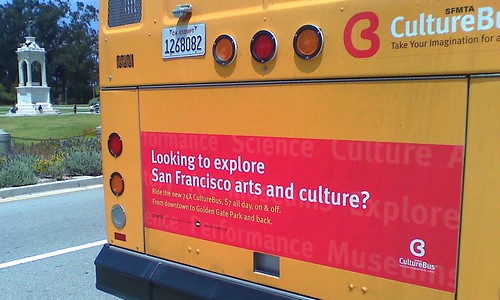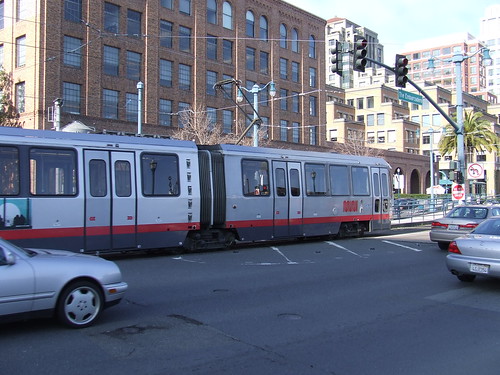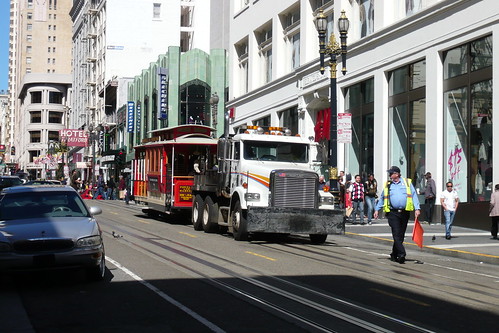
You might think I'm crazy by what you read in the title of this blog post, but let me assure you, I'm perfectly sane.
Not long ago, Muni's fare inspectors returned to the task of doing saturation raids on vehicles after alleged complaints the inspectors were insensitive and possibly targeting certain minorities. The saturation tactic is simple, have a group of inspectors raid a vehicle at a stop and check everyone on the vehicle for valid proof of payment. Once the vehicle is done, the next vehicle arrives and they go through the cycle again. For those who fail to show proof, the violator leaves the vehicle and receives a ticket of $75 for the violation.
If people don't pay their "fare share," race or ethnicity is never an excuse for not paying for that bus ride. The agency has to target bus lines that is heavily abused with fare evaders, so if the line is heavily used by a minority group and the bus line has a bad reputation, crying out race/ethnicity is a the sole reason is just pure dumb.
Surely, the inspectors have gained a bad rap in the past years, from photographer Troy Holden encountering inspector #32, to a YouTube video of an inspector harassing a passenger filming on a train. I don't always like them either, but at least they help the agency to collect the revenue, especially with the heavy inspector presence after ballgames at AT&T Park with the thousands of people going home.
--------------------
It made me think about the fare inspectors...
I know the force does not issue enough tickets to cover their entire salaries ($9,844.64 average in tickets vs. a salary of at least $52K a year). In one point of view, Muni spends too much on inspectors that writes out so few tickets, and that means a waste of money. In another point of view, Muni invests into fare inspectors so they help generate more farebox revenue by preventing illegal boarding of vehicles and not paying their share of the price of a pass or single ride.
I have an idea... what if the fare inspectors don't issue tickets for fare evasion?
Here's the reasoning behind it:
The fare evasion ticket is $75. Sure, it sounds a little expensive for us in the general public, but when you have to also think about all the labor that is involved in it:
- The time it takes for the inspector to issue the ticket.
- The people at the SFMTA office must process every handwritten ticket.
- If the fine is paid at the SFMTA in-person office, the time and salary must be taken into account to process the money; if paid in check, the check cashing fees of the bank as well.
- If the fine is paid online via the SFMTA website, there is a nice surcharge just for the service.
- If the fine is paid through the mail, the cost and salary of the person(s) who must process the payment and update their databases.
- If the case must be appealed, the time and salary of the appeals officer.
- If the ticket must go to collections, the cost of using the collections agency.
- Lastly, the cost of having the armored trucks and the armed guards to haul the sacks of money and checks to the bank.
If fare inspectors didn't issue tickets for fare evasion, what will they resort to? The answer is: ejection from the vehicle.
If a saturation raid finds fare evaders, they kick them off the vehicle and make sure that the next vehicle they board, they pay the farebox for their ride. For those inspectors who ride in pairs in vehicles in motion on the streets, the fare evader is kicked-off to the next available stop while the passenger has fun waiting for another vehicle in 20 minutes.
What this does is saves the SFMTA a lot of resources. I've already mentioned the cost of issuing and processing a $75 ticket, but also realize the fare inspector tickets are processed like parking tickets. For those who appeal their parking tickets, you know the many months it takes to get a decision, and by dramatically reducing the contested fare evasion tickets, this reduces the parking appeal backlog.
For the fare inspector force, they are able to be on more vehicles and conduct more inspections. If writing a ticket takes five to fifteen minutes (depending on hostile the person is), that's wasted time for the inspector to be roaming up and down the lines they are assigned to find more evaders and kick them off the bus. Also, with a uniformed presence, they can also help prevent some of the other bad stuff that goes on, like the graffiti that costs us taxpayers hundreds of thousands of dollars a year.
The SFMTA used to issue fare evasion tickets by treating them like traffic violations. Each citation required the person to appear in court, and that put a major strain on the justice system already flooded with other cases that are much more serious than evading a bus fare. The city passed a new law by decriminalizing fare evasion and making it the same as a parking ticket. Maybe it's time to realize that by even making a fare evasion ticket decriminalized still messes-up the system that has to process all those $75 tickets.
I have to admit, my idea is not perfect. It won't work well on the Muni metro system in the underground portions because if the inspector is stationed at a exit and the passenger is to leave the system, the inspector can't really kick the passenger out of the paid area, the passenger is about to leave the system. In this case, the inspector would issue a $75 ticket.
Tell me your thoughts about this idea. Have I gone nuts?


Why just stick with the $75? Why not raise the fine to something like $250? I think VTA fines are around that range.
ReplyDeleteI think it's a good idea. However, is being thrown off the bus enough of a deterrent? If the only penalty is having to wait 20 minutes for the next bus,it may not encourage fare payment.
ReplyDeleteOne other factor: does overall fare collection rise when people know the inspectors are out there? In other words, does the total MUNI take rise enough to cover all the costs you outlined?
Another issue with the fare inspectors at the turnstiles has to do with the Clipper system. If the machine is broken, then user is supposed to ride free but get no transfer. However, at the turnstile, the rider has no way to prove that the machine on the vehicle was broken. By the time the user makes it to the turnstile, the train is likely gone already.
ReplyDeleteHow about this? Actually test the system as it stands.
ReplyDeleteTotal the costs of issuing and processing tickets. Subtract the revenue collected. If the process costs more than it returns - Scrap it and do the following.
No checks on passengers exiting or riding. Enforcement at gates and aboard vehicles. Naturally there would never be 100% coverage, even if there were more fare enforcers - but at least we would not be harrassed and made to feel like criminals.
I can afford the extra time to walk or I can take BART for many of my in SF trips. Therefore I do not ride MUNI anymore. If the fare inspectors went away in favor of a fare enforcement policy, I'd be able to ride MUNI again.
Does nobody else find the present system intolerable?